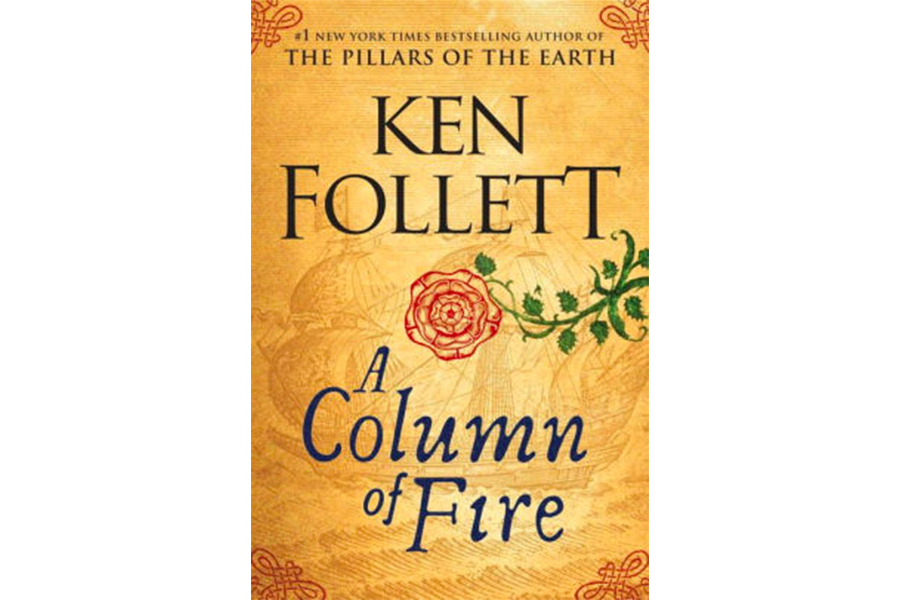'A Column of Fire' is half historic epic, half thriller – all of it engaging
Loading...
Some readers may forget that, before Ken Follett became a best-selling writer of historical fiction epics, he came to prominence cranking out thrillers and spy novels. In A Column of Fire, Follett combines his writing passions, telling an expansive story chronicling 50 years of Protestant-Catholic battles in England through the lives of spies, secret agents, and others on both sides of the conflict.
The new book is set in the fictional wool-trading market city of Kingsbridge, a town first encountered in “The Pillars of the Earth.”
“Pillars,” published in 1989, tells the story of the people building a cathedral in Kingsbridge over a 40-year period during the 1100s.
To the surprise of many, including the author, “Pillars” became a bestseller. It remains Follett’s most popular and beloved book, still selling about 100,000 copies per year in the US, according to the author.
In a preface written for a later edition of the book, Follett called his cathedral epic “an unlikely book for me to write – and I almost didn’t. I started it, then dropped it, and did not look at it again for ten years.… In the book business, when you have had a success, the smart thing to do is write the same sort of thing once a year for the rest of your life.”
Though he wrote a variety of novels after “Pillars,” in 2007 he published “World Without End,” a loose sequel that marked a return to Kingsbridge.
“World Without End” takes place about 200 years after “Pillars,” amid the plague epidemic later known as the Black Death. The politics of the medieval church serve as the backdrop for an epic following the lives of the descendants of the first Kingsbridge book.
For the past decade, Follett has concentrated on a different sort of historical fiction. He published the more-than-3,000-page “Century Trilogy” of novels between 2010 and 2014, a series that, like the best historical fiction, seamlessly blends authorial inventions with real-life characters. The trilogy ranges from the Russian Revolution through both World Wars to the American civil rights era and on to the end of the Cold War, told in the eyes of five families and their descendants.
Now Follett returns with the final (we think) Kingsbridge story, once again skipping ahead a couple of centuries in time to the Elizabethan era. None of the books in the series need to be read in order.
“A Column of Fire” features a sprawling cast, but its principal characters are oft-thwarted lovers on opposite sides of the Protestant-Catholic schism: Ned Willard, an ambitious, clever aide to Queen Elizabeth who becomes entrusted with stamping out various plots by extremists, and Margery Fitzgerald, a devout Catholic who helps smuggle priests into England but who also opposes the violent religious resistance against Protestantism favored by her older brother.
Margery’s older brother, Rollo, happens to be Ned’s rival – and a cunning insurgent.
For readers already steeped in Follett’s Kingsbridge mythology, Easter eggs abound, including allusions and references to Merthin Fitzgerald, Tom and Jack Builder, Prior Philip, and Caris, pivotal characters from the earlier books.
A more violent version of the Protestant-Catholic split in France attracts Ned and Rollo, who, for different reasons, seek to infiltrate the machinations there. A malevolent schemer named Pierre Aumande, the humble son of a country priest, works his way into the employ of powerful cardinals as a spy who entraps French Protestants.
Pierre is mostly an opportunist when he is introduced as a petty scammer, but, soon enough, extremists stir his baser instincts. The powerful forces steering Pierre include members of the real-life House of Guise family of French Catholic officials.
In one memorable exchange, a hardline priest tells Pierre, “Earlier this year the accursed Queen Elizabeth of England imposed Protestantism on her wretched subjects, who are now deprived of the consolation of the sacraments. Tolerance is spreading. This is the horrible truth.”
One of Pierre’s victims, an idealist named Sylvie Palot, will prove to be a brave and resourceful smuggler of French-language Bibles. That sounds mundane, but, of course, in that place and time such actions were a crime punishable by execution.
What Follett does best he does again in “A Column of Fire”: Introduce a sizable and memorable cast, have them intermingle with historical figures and somehow hang on to just enough verisimilitude so that the Dickensian coincidences and callbacks captivate without distraction. Follett remains an old-fashioned storyteller in the best sense, avoiding, for the most part, excessive historical analysis and look-at-me-research in favor of revealing the hearts and minds of his characters.
And he never, ever forgets the most important aspect of any story: keep it moving.
A prime example: “The result was carnage,” he writes, describing a pivotal naval encounter. “Against the bright orange blaze of the fire he could see the black outlines of the men in the pinnaces jerk, like crazed devils cavorting in hell, as they were riddled with bullets. The cannons must have been loaded with shot or stones. The men appeared to be screaming, but nothing could be heard over the roar of the flames and the crash of the guns.”
Follett’s historical epics, including this one, evoke the Romantic adventures of Alexandre Dumas. Derring-do and double-crosses, as well as the sorrows of a more violent and precarious existence, abound.
The new novel ends on a well-struck note, bittersweet but with a nod to future adventures that may or may not lead Follett down still another path of political and religious intrigue. In other words, “A Column of Fire” burns bright throughout.






